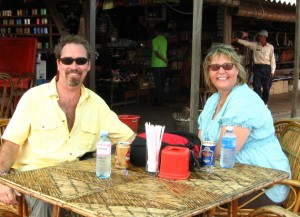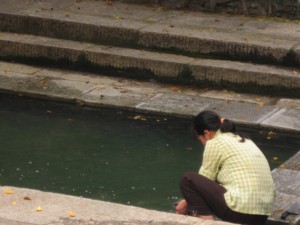
I was thinking about how to find safe drinking water in another country a couple of weeks ago. I was sitting in sand with a friend, sweating and thirsty in Mexico’s Gran Desierto de Altar after we each hauled10 gallons of water five miles into the desert to bury.
Our plan is to trek across the wild dune fields to the cache next week, refill our depleted water containers and continue on for another two to three days to our pickup point.
If something happens to that water cache, we have an emergency option by hiking east to a well at Pozo Nuevo. But we would have to treat it, and that means having some sort of way to purify the water.
Which is why I was sitting there in the sand thinking of drinking water in other countries. Isn’t it nice when things come full circle?
Specifically, I was realizing that everywhere Julie and I have traveled we’ve been able to find purified drinking water. Of course that means water in those ubiquitous and environmentally disastrous plastic bottles.
But unless you’re really heading off the beaten path, it also means you don’t have to worry so much about that moth-eaten admonition “Don’t drink the water,” when traveling abroad.
I digress but don’t you love it when people who never travel give you advice about another country? I can’t recall how many times I’ve been planning a trip south of the border, and been told “Don’t drink the water” by someone who’s never been to Mexico.
Sheesh.
Anyway with purified bottled water available in most communities worldwide, and easy ways to purify water if it’s not available, you should be able to stay hydrated while traveling.
Finding bottled drinking water.

Most restaurants, stores and shops sell purified, bottled water. You can also buy it from street vendors, but be especially aware of unscrupulous vendors (say what? unscrupulous vendors?) who refill empty bottles with local tap water. So be sure to inspect the cap, and refuse it if it looks like it’s been opened.
However you can still end up drinking the local water. In Cambodia, after hiking to Kbal Spean and back, we bought a couple of beers from a local vendor while waiting for our tuk tuk driver to return from fixing a tire. Our day had been amazing and we were hot and pumped up and decided to have another celebratory beer. And another. When our driver showed up we were really happy until we watched him buy a soda from the vendor and thoroughly wipe the edge clean with his shirt. Slowly grasping the situation, I asked him why he was doing that. “Bacteria,” he responded.
The vendor was storing her beverages in a cooler full of ice water. Within 48 hours I had run the course from cramping to diarrhea and dehydration. Strangely, Julie didn’t seem affected.
So be aware of how your water was stored and at least wipe off the bottle’s mouth. Also, I’ve seen plenty of people order a bottle of water at a restaurant, only to pour it into the ice-filled glass the waiter so innocently provided. If the ice isn’t purified, what’s the point of the bottled water?
Ways to purify water when traveling.
Okay so you are heading off the beaten path after all, and you’re not sure if purified water is even available. Or you want to reuse the water bottles you have, rather than see empty ones build new continents in the Pacific Ocean. No problem. You can make water safe to drink with a variety of methods:
Aqua Mira Water Treatment Drops — I use this two-part chemical mixture to treat water when backpacking in the wilds. Although we always bring it, we’ve never had to use it when traveling to other countries. It’s inexpensive, easy to use, small enough to pass the TSA carryon liquid requirements and leaves no taste (unlike iodine). The downside is it’s a chemical — chlorine dioxide — and though it’s supposedly safer than other chemicals (iodine), I probably wouldn’t want to use it long term.
Iodine — Usually found in tablets, iodine has long been a standby for chemical treatment. It’s inexpensive and easy to use but can leave a chemical taste. It’s also lethal in large doses and not recommended for pregnant women.
For all chemical treatments you’ll want to follow directions to the letter.
Ultraviolet water treatment — Never used these but I want to: they sound really cool. Brands like SteriPEN make a small handheld device like a penlight. Stick it in your glass of water or water bottle, stir around for a bit and — they claim — kill 99.99% of protozoa, bacteria and viruses in a minute or two. The downside: They are expensive and apparently not as effective in cloudy or sediment-laden water. I’d like to hear if someone else has used these.
Filters — There are a lot of different water filters available, including some that desalinate seawater. They work well but can be expensive and need some maintenance. There are even filters that integrate with water bottles for convenience.
Boiling — According to the CDC, boiling water is the most effective way to make it safe. They recommend boiling for one minute (three minutes at high altitude above 6,562 feet or 2,000 meters) and allowing to cool to room temperature. The downside: You’ll need a pot and heat source, and boiled water has a funky taste.
If the local water is looking particularly nasty, you may want to combine efforts such as filtering and then treating.
Bottoms up!

Leave a Reply